 Autoharp Factory Chord Setups |
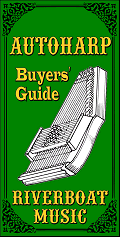 |
| 

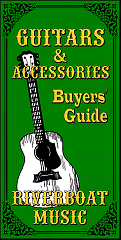
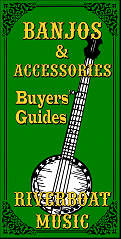
| Autoharp Factory Chord SetupsEach of the four most popular factory autoharp configurations has historically been set up to play in a certain number of keys (based on a simple 3-chord song). Unfortunately for fans of traditional Folk, Old-Timey, and Fiddle music, the earliest autoharps were invented when brass bands were still in vogue, and as they expanded the number of keys they would support, they added more trumpet-friendly keys (with flats) than they added guitar-friendly keys (with sharps).
Why Song Keys Don't Tell the Whole StoryMany, many songs, especially Folk and Country songs can get by with just three chords, say G, C, and D7 or D, G, and A7. But there are many other songs that need extra chords. And that's where those extra chord bars come in. A song in the key of F, for example, will almost always use Bb and C (or C7). But it may also need Am, Dm, G, Gm, and G7, especially if it's a Tin-Pan Alley song, Jazz standard, "Pop" song, "Worship" song, and many Country songs. You might consider those chords "supplementary" in the key of F. If you're playing a standard OS or Chromaharp autoharp, you'll almost always have all the "supplementary" chords you need to play in F (or in Bb and Eb, if you have a 21-key harp).Now, say you're moving from your Ragtime Banjo Society gig to a Folk, Bluegrass, Celtic, or Country gig, and your new bandmates want to do the same song in A that you're used to playing in F. You'll discover in a heartbeat that you don't have the chords you need, which may include, not only D and E7 but also A, Em, and B7 (present on a 21-chorder, but not on a 15-chorder) as well as E, Bm, F#m and maybe even C#m. So it's easy to say that you can play songs in the key of A on a 21-chord autoharp, but that isn't the same as saying that the instrument is SUITED for playing in the key of A, unless you're committed to playing only the simplest possible tunes. Sharp-Friendly VariantsOscar Schmidt and Chromaharp haven't been entirely deaf to the pleas of Folk, Bluegrass, or Country artists (who usually play in guitar, fiddle, and mandolin-friendly keys like G, D, A and E).
Again, autoharps (especially 21-chord Oscar Schmidts) can be reconfigured to play in sharp keys or for other reasons, but before you buy the next used autoharp you see, take some time to determine what model will best serve your purpose. Starting With the BasicsI started to write another article before I wrote this one, about reconfiguring autoharps to play your favorite keys. Then I realized that much of what I "knew" about autoharps was misguided, to say the least, by only being really exposed to a handful of instruments and following "experts" who often repeated "urban legends" they had learned from other "expert." I also figured that telling folks what they could change their autoharps TO without being clear what they were changing them FROM would be less than helpful for folks who are wondering if, say, that $100 autoharp on Craigs List would be a good starting point.
The "A Reissue" is okay, though - its chord bars are placed for upright playing. Early Factory SetupsWe're starting our review way back in the 1880s, when Zimmerman expanded on Gutter's design for 3-chord autoharps to allow 5 chords. And then 8- and 12-chord instruments. True, the 12-chord autoharps didn't really make a splash until Oscar Schmidt took over in the 1920s, but the designs were there all along.Why go back to ancient history? Because the way Zimmerman laid out the chord bars on his 5-chord and 12-chord instruments influenced the way the majority of factory-built autoharps are still being made today (21-chorders and custom autoharps being the exceptions).
A "store-bought" 5-chord autoharp (an early model not made today) typically includes buttons for Bb, C7, F, G7, and C. This enabled playing three-chord songs in F and C.
| ||||||||||||||||||||||||||||||||||||||||||||||||||||||||||||||||||||||||||||||
 |
 |
A "store-bought" 15-button Oscar Schmidt or Chromaharp autoharp (the most popular entry-level autoharps today) includes buttons for Eb, Bb, F, F7, C, C7, G, G7, Gm, D7, D, Dm, A7, Am, and E7. So you see that, as equipped, a 15-button autoharp can play three-chord songs in  Bb, F, C, G, and D, which is an improvement, but still neglects A and E.
Bb, F, C, G, and D, which is an improvement, but still neglects A and E.
Note: That this arrangement keeps the "basic" 12 keys the same, which puts the D chord almost out of reach of the G chord that would typically be played in the key of D.
Moreover, as a Folk singer who plays a lot of songs in D, I'm used to having access to Em, Bm, and F#m on guitar, banjo, and mandolin. So many complex folk-style songs like "City of New Orleans" are still out of the question.
Other 15-Chorders - Several experimental and educational 15-chorders were also produced. These include the guitar-inspired Oscar Schmidt Guitarros, RBI Chromalin, and RBI Chroma II, as well as briefcase-style autoharps for music teachers: the Oscar Schmidt Educator and the RBI Portaharp. All of these used the "Berkshire" chord arrangement shown above (with the very rare exception of a few 21-chord Educators, which used the standard 21-chord setup described below).
A Note About 15-Chorders as First Instruments - Millions of 15-chord Oscar Schmidts and Chromaharps have been built over they years and quite a few come on the used market in something close to playable condition. They are almost always much cheaper than used 21-chorders in similar condition. (For tips on buying autoharps used, check out our article "Shopping for Used Autoharps.)
New 15-chorders tend to be about 25% cheaper than the new 21-chord versions, so the price difference isn't as great.
So both used and new 15-chorders tempt folks who don't want to spend a lot of money on an instrument that they're just trying out. If you're buying used and can get a playable 15-chorder for a very good price, you'll learn a lot from it. (BTW, these days, Chromaharp 15-chorders seem to have better quality control than Oscar Schmidt 15-chorders, so don't let the Chromaharp brand put you off.)
That said, if you want to buy new, the price difference between a 15-chorder and a 21-chorder isn't as great. You may be better off saving a little longer and starting with a 21-chord version. That said, a lot of folks who start out on a 15-chorder and go to a 21-chorder later, find other uses for their first harp, like making it diatonic.
Trying to be Folk- (and Bluegrass-) Friendly During the Folk Revival, the rise of Bluegrass, and the mainstreaming of Country music, autoharp players clamored for more guitar-friendly chords on their instruments. Both Chromaharp and Oscar Schmidt heard them, sort of. They produced 15-chorders that gave you E and A chords by sacrificing the Eb and F7, two chords you almost never need in Folk, Bluegrass, or Country. But they didn't go far enough.
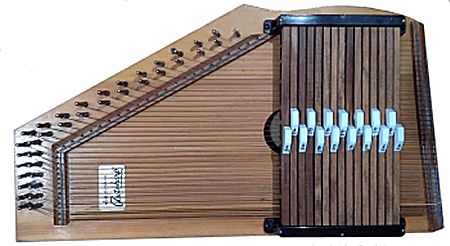 |  |
 The O.S. Appalachian and Chromaharp "Bluegrass" models shown above give you E and A chords by sacrificing the Eb and F7 chords. (The instrument includes Bb, F, C, C7, G, G7, Gm, D, D7, Dm, A, A7, Am, E, and E7.) So you can play simple songs in F, C, G, D, and A.
The O.S. Appalachian and Chromaharp "Bluegrass" models shown above give you E and A chords by sacrificing the Eb and F7 chords. (The instrument includes Bb, F, C, C7, G, G7, Gm, D, D7, Dm, A, A7, Am, E, and E7.) So you can play simple songs in F, C, G, D, and A.
Surprisingly, about a quarter of the 15-chord Silvertones were also produced with the Appalachian arrangement. They look just the same as the standard Silvertones, but if you go looking for this chord setup, don't overlook Silvertones.
So if you are playing with a fiddler who loves doing old-time fiddle tunes, you can play along (and trust, me, you'll never miss Eb or F7 in that environment).
On the other hand, if you're playing with a guitarist who wants to do anything by Paul Simon, James Taylor, Judy Collins, Gordon Lightfoot, Steve Goodman, Noel Stookey, Dolly Parton, Garth Brooks, or most other Folk, Folk-Rock, or Country artists, you'll probably be missing chords you need, like Em, Bm, and F#m to name a couple.
Note: Like the standard 15-button autoharp, this arrangement keeps the "basic" 12 keys the same, even though playing in D is still awkward, and the reach from A to E7 is "dicey." That said, as long as you don't disassemble your autoharp over shag carpet, there is no compelling reason you can't move the keys around to make your favorite keys easier to play.
Note about Oscar Schmidt "Appalachian": As shown above, the 15-chord Oscar Schmidt "Appalachian," made in the 1970s, looked pretty much like their other 15-chorders, but used the same layout described above (with A, D, and E in the left three buttons). Aside from looking at the buttons (which you can't read in most eBay or Craigs List ads), one way to tell is that the word Appalachian appears in a box over the Autoharp logo. 
Oscar Schmidt briefly carried this chord arrangement into their "Model B" line (the more streamlined versions that emerged in the late 1960s.) However later versions of the 15-chord Appalachian, including the OS45B, reverted to the standard 15-chord Autoharp setup.
All 21-chord "Appalachians" follow the standard 21-chord setup (below). Some were cooler looking, with a flower-shaped tone hole, but - despite the cool looks and manufacturer promises - were no more "suited for Bluegrass" than any other 21-chorder in their lineup. (Note: The early 21-chord flower-designed "Appalachian" was replaced with a round-holed version, and the word "Appalachian" was removed, but the model number, OS45C remained the same.)
Sadly, the Chromaharp Bluegrass model and the early Oscar Schmidt "Appalachian" fell far short of giving Folk, Bluegrass, and Country musicians what they needed (more chords to support playing in sharps). The few that remain are more-or-less oddities, unless some inventive person has reconfigured them with useful chords.
I have owned one of each, and I did reconfigure my Chromaharp Bluegrass. I converted E7 to Em (a much more useful chord in keys like C, G, and D.) I also rearranged the chord bars to bring D and G closer to each other. For a description of that project, click here.
For more information about the early OS45 "Appalachians," click here.
21-Chorders (OS21s, etc.)
The Oscar Schmidt OS-21C (below left) finally broke away from the 5- and 12-chord bar sequences that had dominated the Oscar Schmidt line for eighty years. In its day, it was quite revolutionary to have one row for major chords, one row for seventh chords, and one row for minor chords - most of them arranged in the "circle-of-fifths" sequence that musicians use and often depend upon. |
 |
 If you're playing one of these in keys like Bb or F, you have a lot of extra chords to use for fancy arrangements. In addition, with most of the buttons being arranged in a "circle of fifths" sequence, when someone decides to pitch a song in C instead of D, all you have to do is move your left hand over a couple buttons.
If you're playing one of these in keys like Bb or F, you have a lot of extra chords to use for fancy arrangements. In addition, with most of the buttons being arranged in a "circle of fifths" sequence, when someone decides to pitch a song in C instead of D, all you have to do is move your left hand over a couple buttons.
Not "Ideal for Bluegrass" - Still, the 21-chord version isn't much more helpful to a player of Folk, Bluegrass, Celtic, or country than the early 15-chord "Appalachian" model (above). You can play 3-chord songs in D or A, but you can't play complex songs in those keys - you're missing Bm and F#m. And you can't play in E at all. In fact, unlike the first-generation OS-45s, this setup lacks even an E major chord.
For a time, Oscar Schmidt claimed that the OS-45C with the flower-shaped hole was "Ideal for Bluegrass," even though it had the standard 21-chord setup. Pretty? Yes. Ideal for Bluegrass? No. But keep reading.
The "Americana" - More Folk-, Bluegrass-, and Country-Friendly
In the meantime, professional autoharp players like Bryan Bowers were coming up with chord arrangements that made sense for autoharpers who wanted to play music with other musicians who play acoustic guitar, banjo, fiddle, mandolin, etc. Custom autoharp builder Pete d'Aigle, proprietor of Daigleharp.com, came to favor this setup as well. And because swapping and reconfiguring chord bars on 21-chord Oscar Schmidts is fairly easy, any number of other autoharp builders and players adapted Bowers' setup to their own configurations.
were coming up with chord arrangements that made sense for autoharpers who wanted to play music with other musicians who play acoustic guitar, banjo, fiddle, mandolin, etc. Custom autoharp builder Pete d'Aigle, proprietor of Daigleharp.com, came to favor this setup as well. And because swapping and reconfiguring chord bars on 21-chord Oscar Schmidts is fairly easy, any number of other autoharp builders and players adapted Bowers' setup to their own configurations.
Oscar Schmidt eventually asked Pete D'Aigle if he would have any problem with them using his version of the "Bowers setup" on a new autoharp. He said "of course not," and even wrote some maintenance procedures for OS.
So Oscar Schmidt eventually released the "Americana" 21-chord model OS110 21AE, using Bowers' chord bar arrangement.
 The Americana came with E major, B minor, and F# minor chords (sacrificing Ab, Cm, and Bb7, three chords acoustic musicians almost never use.)
The Americana came with E major, B minor, and F# minor chords (sacrificing Ab, Cm, and Bb7, three chords acoustic musicians almost never use.)
This lets you play complex songs in Bb, F, C, G, D, and A, and lets you play 3-chord songs in E.
It also swaps the position of the major and seventh chords, and puts the relative minor closer to the major chord (so Am is closer to C, etc.).
That said, if you're used to a standard 21-chord autoharp, you'll have to retrain your left hand a little.
Ooops! From the current Oscar Schmidt page (May, 2025), it looks like the Americana has been discontinued.
That said, it's not that hard to reconfigure a 21-chorder into this setup. Please refer to our article "Making Your Autoharp Folk-Friendly" for tips.
I've done this conversion on OS-73C (which is also a 21-chorder). That project, with links to an accompanying video, is described here.
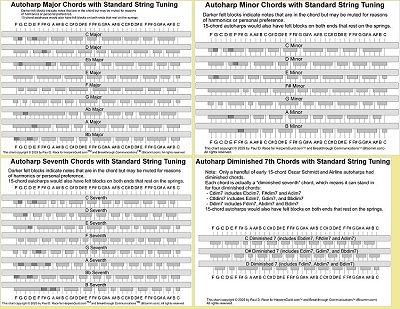 Chord Bar Felt Configurations
Chord Bar Felt Configurations
Because of user questions about chord bar issues, we've put together a page showing the felt configurations for all common standard autoharps, including 12, 15, and 21-chorders. Click here to see the page.
Conclusion
Just about any Oscar Schmidt or Chromaharp can be reconfigured for different chords, and even different numbers of chords. So you have more flexibility than you might think. But I did think it was important to be clear about how these thing tend to be set up from the factory.When I wrote this article, I had five autoharps. Now I have far too many, and I've learned some things that caused me to go back and make changes to the content here. I have also done some tweaking on my instruments that is reflected in other articles.
Short version - a used, but playable 15-chord Oscar Schmidt or Chromaharp will get you started, though it will seem limited in some settings. An Oscar Schmidt or Chromaharp 21 chorder will let you play more songs in more keys, but many advanced players find they need chords that aren't on those instruments. In that case, the Oscar Schmidt 21-chorders are far easier to reconfigure than the Chromaharps. But ANY autoharp can be tweaked to make it more useful for the kind of music you want to do.
More tips about your first autoharp are provided in our RiverboatMusic.com Autoharp Buyer's Guide.
And if you need more specific information, you can contact us through our Contact Page.
Best of luck!
 Whatever else you get out of our pages, I hope you come away with some great ideas for "sharing the joy."
Whatever else you get out of our pages, I hope you come away with some great ideas for "sharing the joy."
And please stay in touch!
All material, illustrations, and content of this web site is copyrighted ? 2001, 2002, 2003, 2004, 2005, 2006, 2007, 2008, 2009,
2010, 2011, 2012, 2013, 2014, 2015, 2016, 2017, 2018, 2019, 2020, 2021, 2022, 2023, 2024 by Paul D. Race. All rights reserved.
Creek Dont' Rise(tm) is a participant in the Amazon Services LLC Associates Program, an affiliate advertising
program designed to provide a means for sites to earn advertising fees by advertising and linking to Amazon.com.
Note: Creek Don't Rise (tm) is Paul Race's name for his resources supporting the history and music of the North American Heartland as well as additional kinds of acoustic and traditional music.
For questions, comments, suggestions, trouble reports, etc. about this page or this site, please contact us.
| Visit related pages and affiliated sites: | |||||
| - Music - | |||||

|
 |
 |

|

|

|

|

|

|

|

|

|

|

|

|

|

|

|
| - Trains and Hobbies - | |||||
 |

|

|  |
 |

|
| - Christmas Memories and Collectibles - | |||||
 |

|
 |

|
 |

|
| - Family Activities and Crafts - | |||||
 |

|

|

|

|

|







